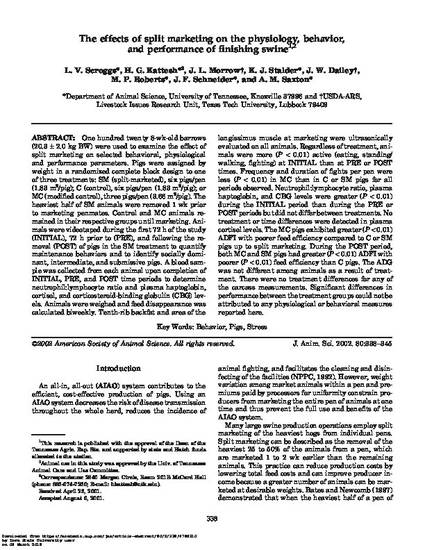
Article
The effects of split marketing on the physiology, behavior, and performance of finishing swine
Journal of Animal Science
(2002)
Abstract
One hundred twenty 8-wk-old barrows (20.3 +/- 2.0 kg BW) were used to examine the effect of split marketing on selected behavioral, physiological and performance parameters. Pigs were assigned by weight in a randomized complete block design to one of three treatments: SM (split-marketed), six pigs/pen (1.83 m2/pig); C (control), six pigs/pen (1.83 m2/pig); or MC (modified control), three pigs/pen (3.66 m2/pig). The heaviest half of SM animals were removed 1 wk prior to marketing penmates. Control and MC animals remained in their respective groups until marketing. Animals were videotaped during the first 72 h of the study (INITIAL), 72 h prior to (PRE), and following the removal (POST) of pigs in the SM treatment to quantify maintenance behaviors and to identify socially dominant, intermediate, and submissive pigs. A blood sample was collected from each animal upon completion of INITIAL, PRE, and POST time periods to determine neutrophil:lymphocyte ratio and plasma haptoglobin, cortisol, and corticosteroid-binding globulin (CBG) levels. Animals were weighed and feed disappearance was calculated biweekly. Tenth-rib backfat and area of the longissimus muscle at marketing were ultrasonically evaluated on all animals. Regardless of treatment, animals were more (P < 0.01) active (eating, standing/walking, fighting) at INITIAL than at PRE or POST times. Frequency and duration of fights per pen were less (P < 0.01) in MC than in C or SM pigs for all periods observed. Neutrophil:lymphocyte ratio, plasma haptoglobin, and CBG levels were greater (P < 0.01) during the INITIAL period than during the PRE or POST periods but did not differ between treatments. No treatment or time differences were detected in plasma cortisol levels. The MC pigs exhibited greater (P < 0.01) ADFI with poorer feed efficiency compared to C or SM pigs up to split marketing. During the POST period, both MC and SM pigs had greater (P < 0.01) ADFI with poorer (P < 0.01) feed efficiency than C pigs. The ADG was not different among animals as a result of treatment. There were no treatment differences for any of the carcass measurements. Significant differences in performance between the treatment groups could not be attributed to any physiological or behavioral measures reported here.
Keywords
- Behavior,
- Pigs,
- Stress
Disciplines
Publication Date
February, 2002
DOI
10.2527/2002.802338x
Publisher Statement
Works produced by employees of the U.S. Government as part of their official duties are not copyrighted within the U.S. The content of this document is not copyrighted.
Citation Information
L. V. Scroggs, H. G. Kattesh, J. L. Morrow, K. J. Stalder, et al.. "The effects of split marketing on the physiology, behavior, and performance of finishing swine" Journal of Animal Science Vol. 80 Iss. 2 (2002) p. 338 - 345 Available at: http://works.bepress.com/kenneth_stalder/173/
